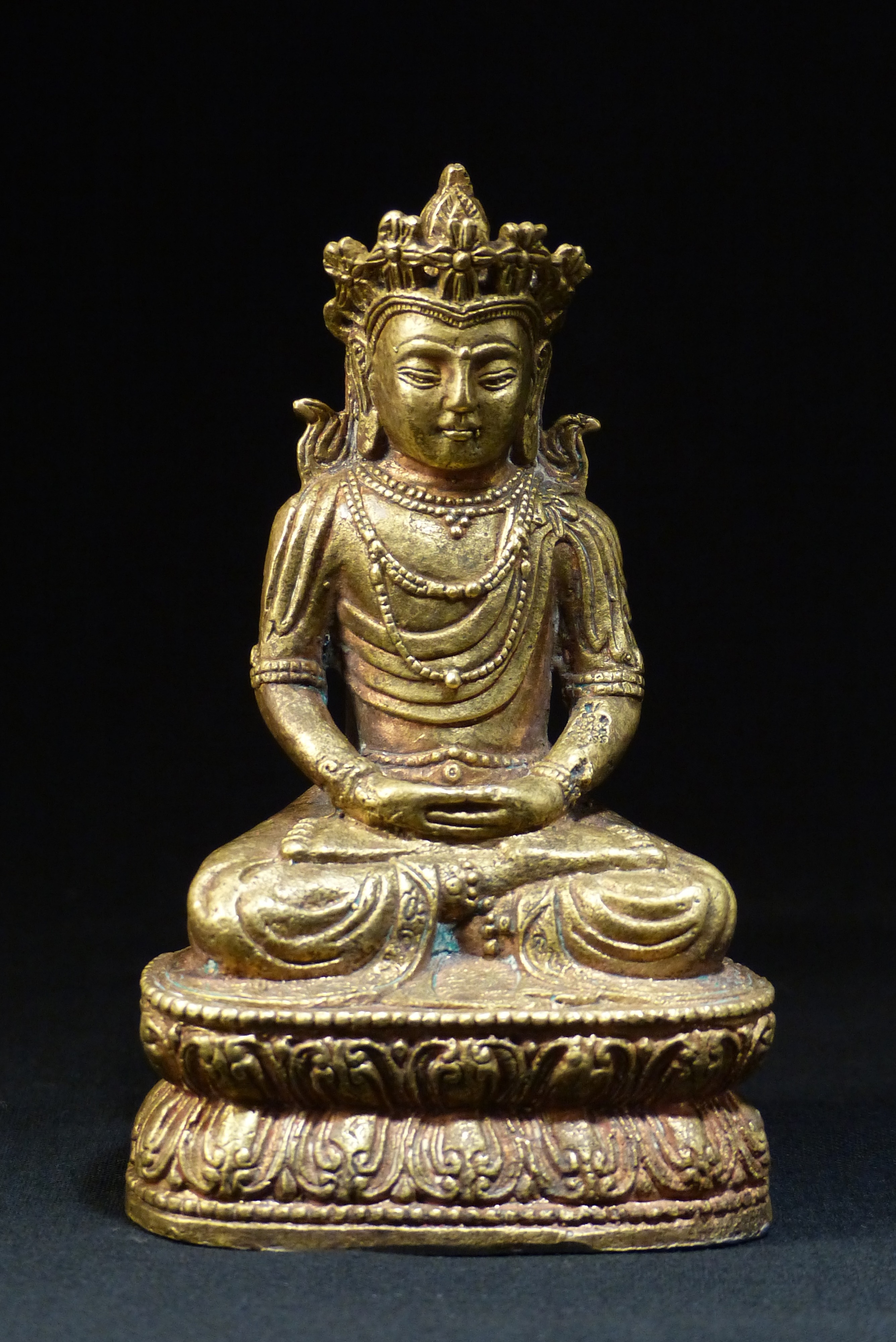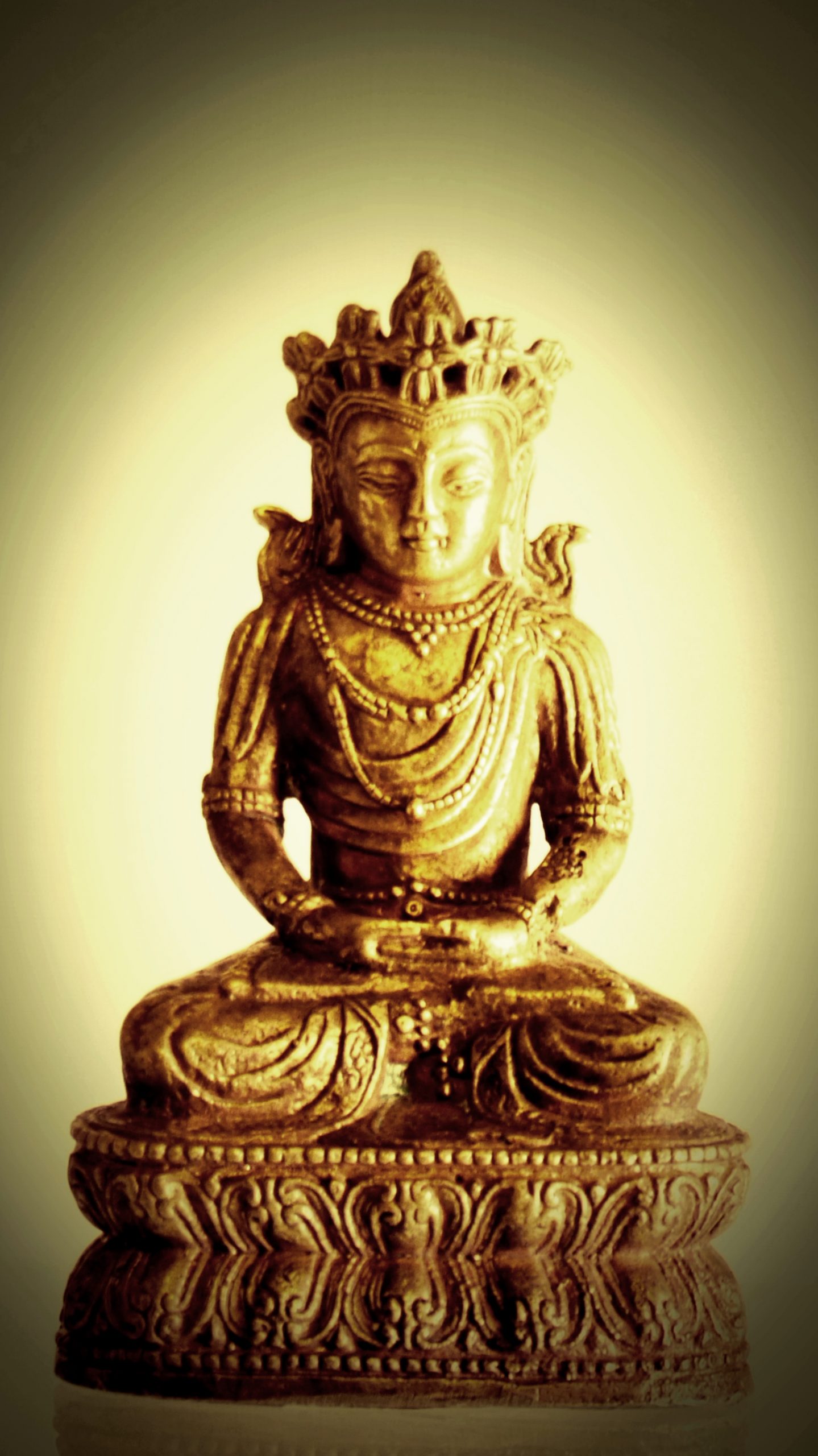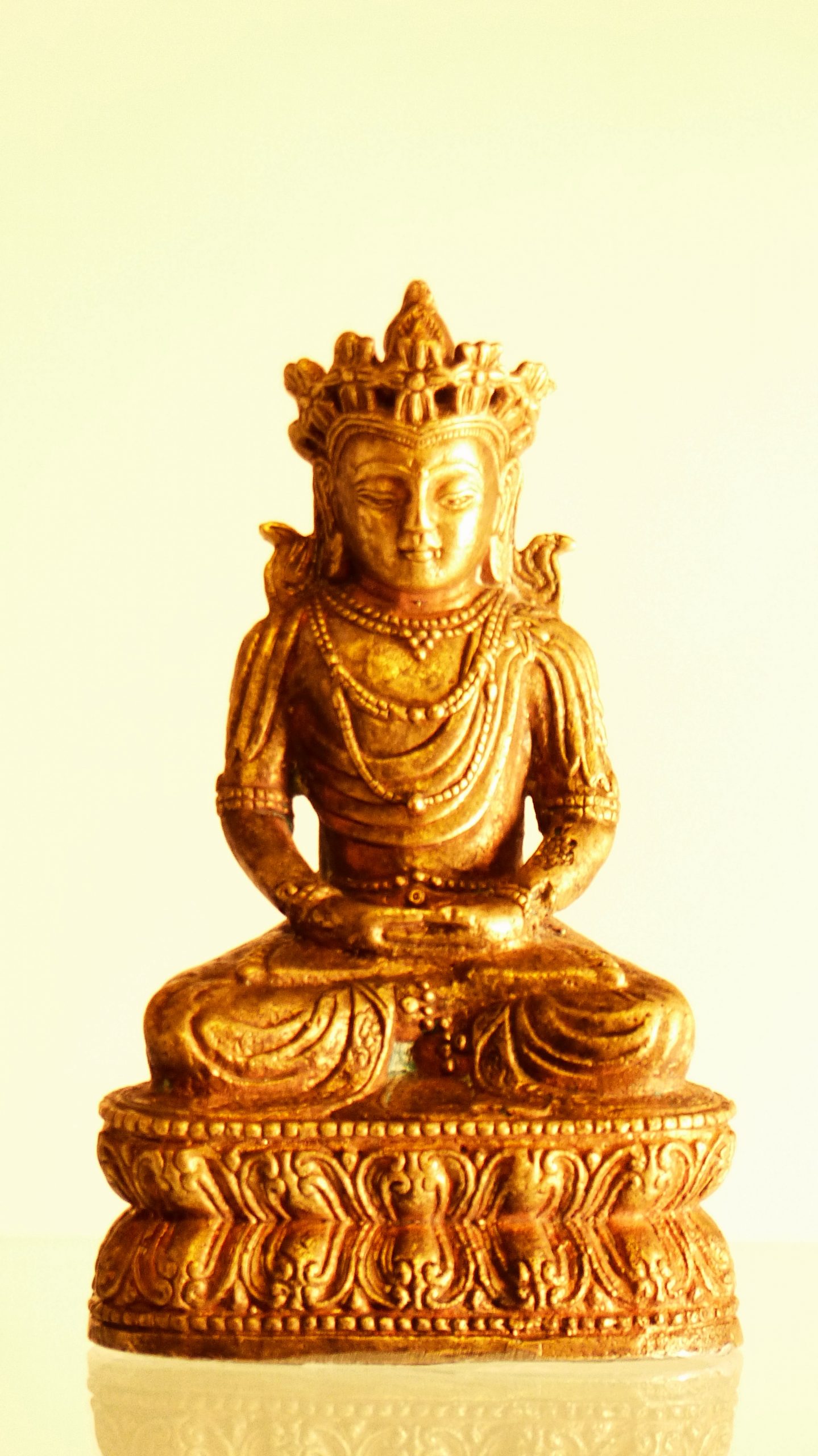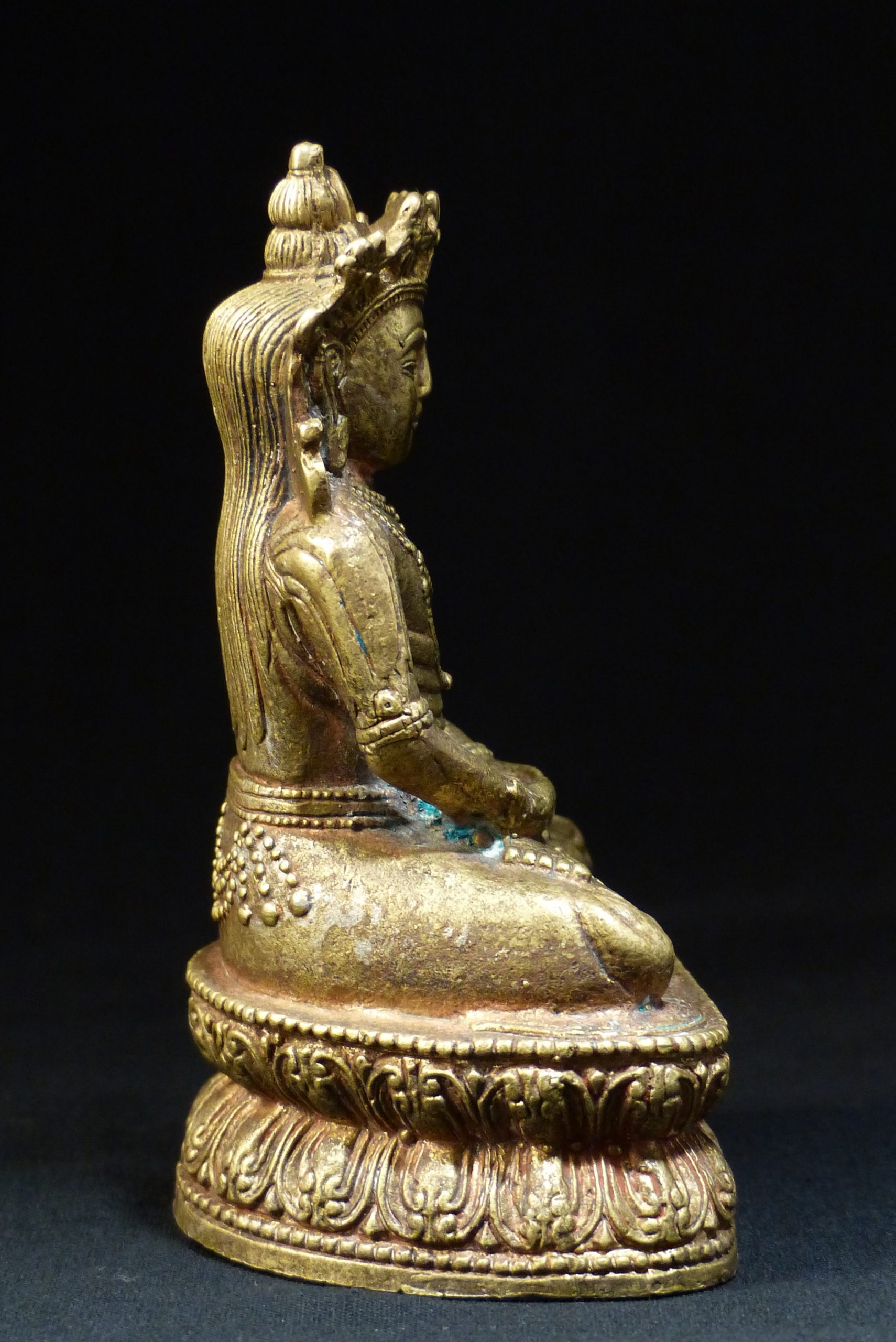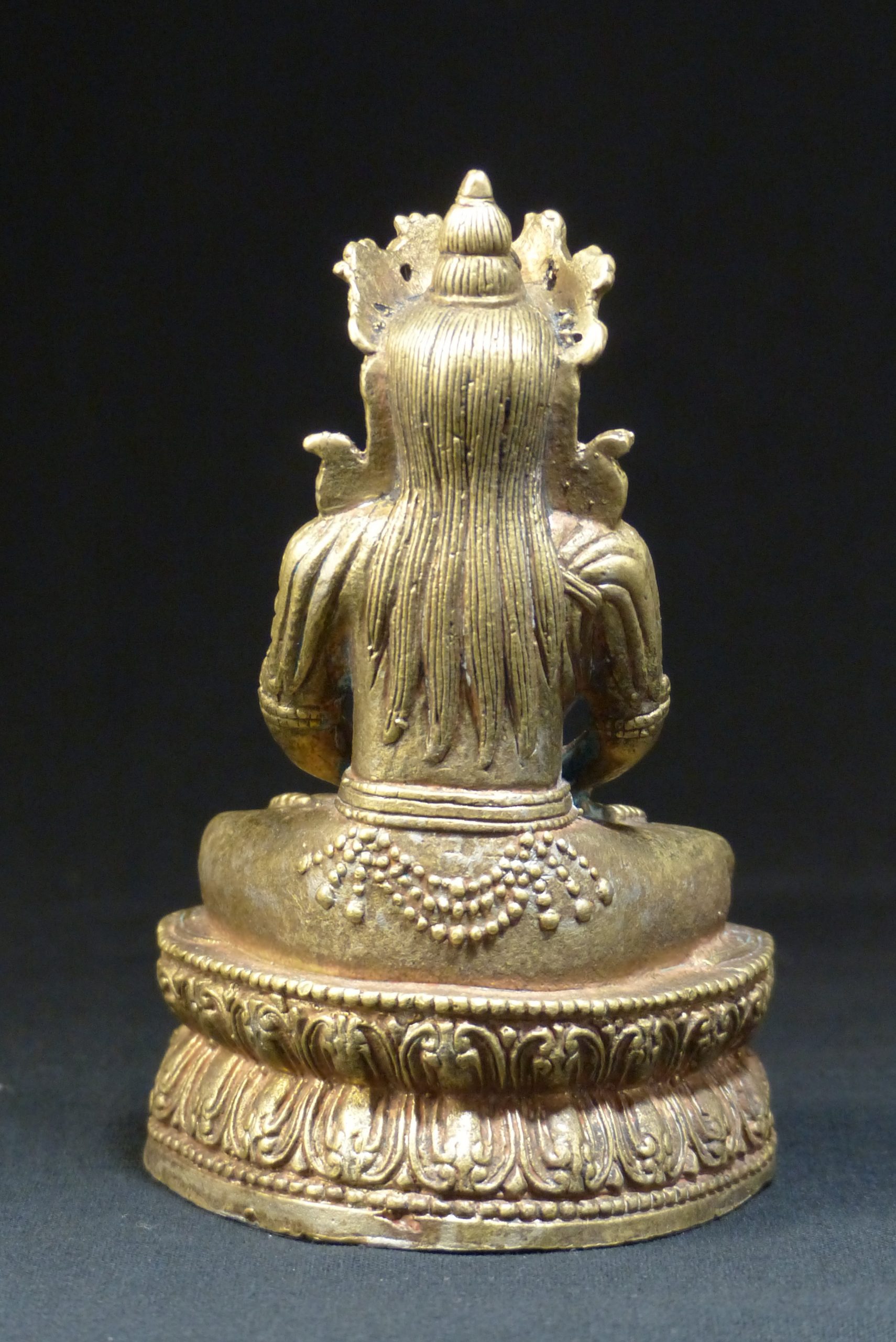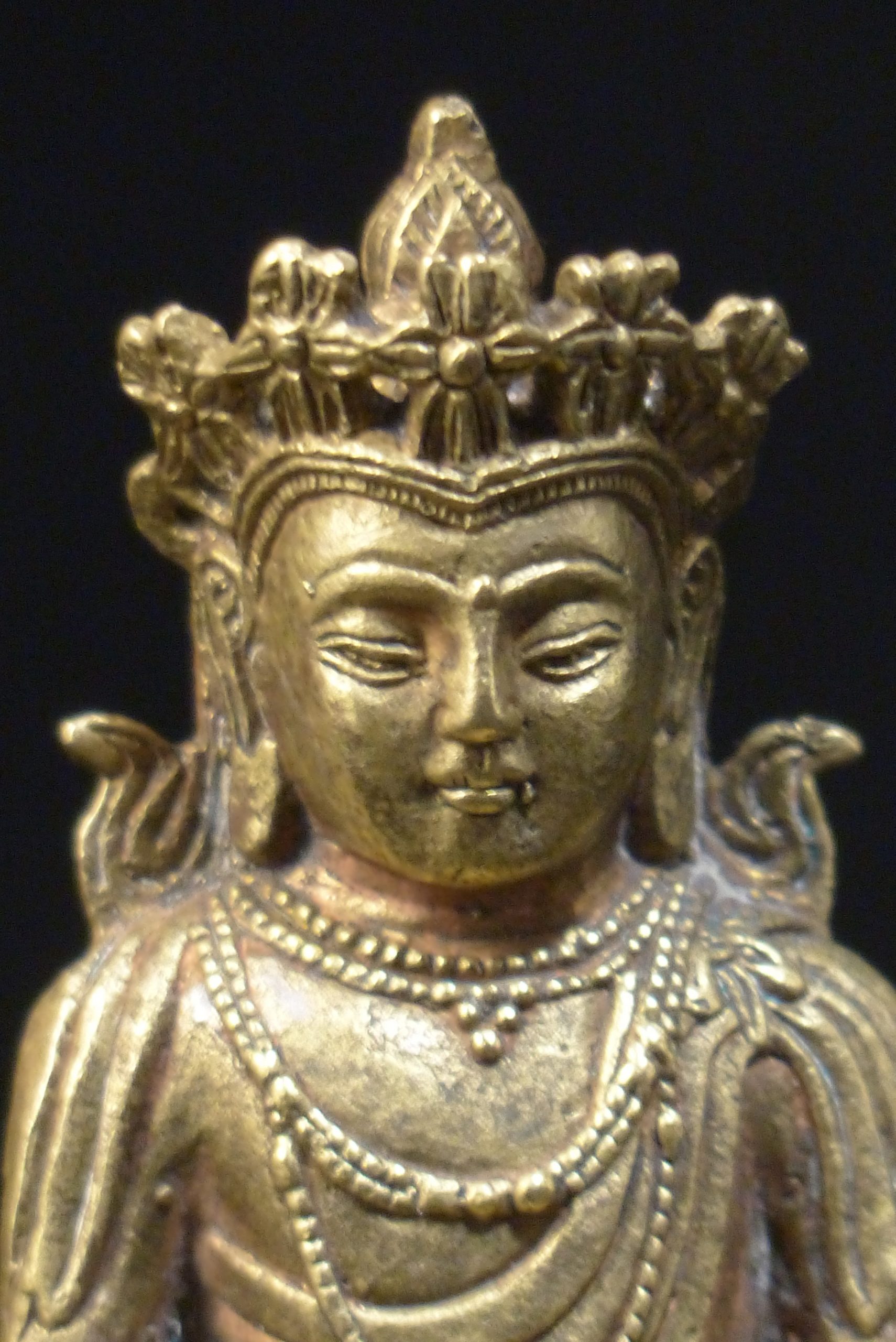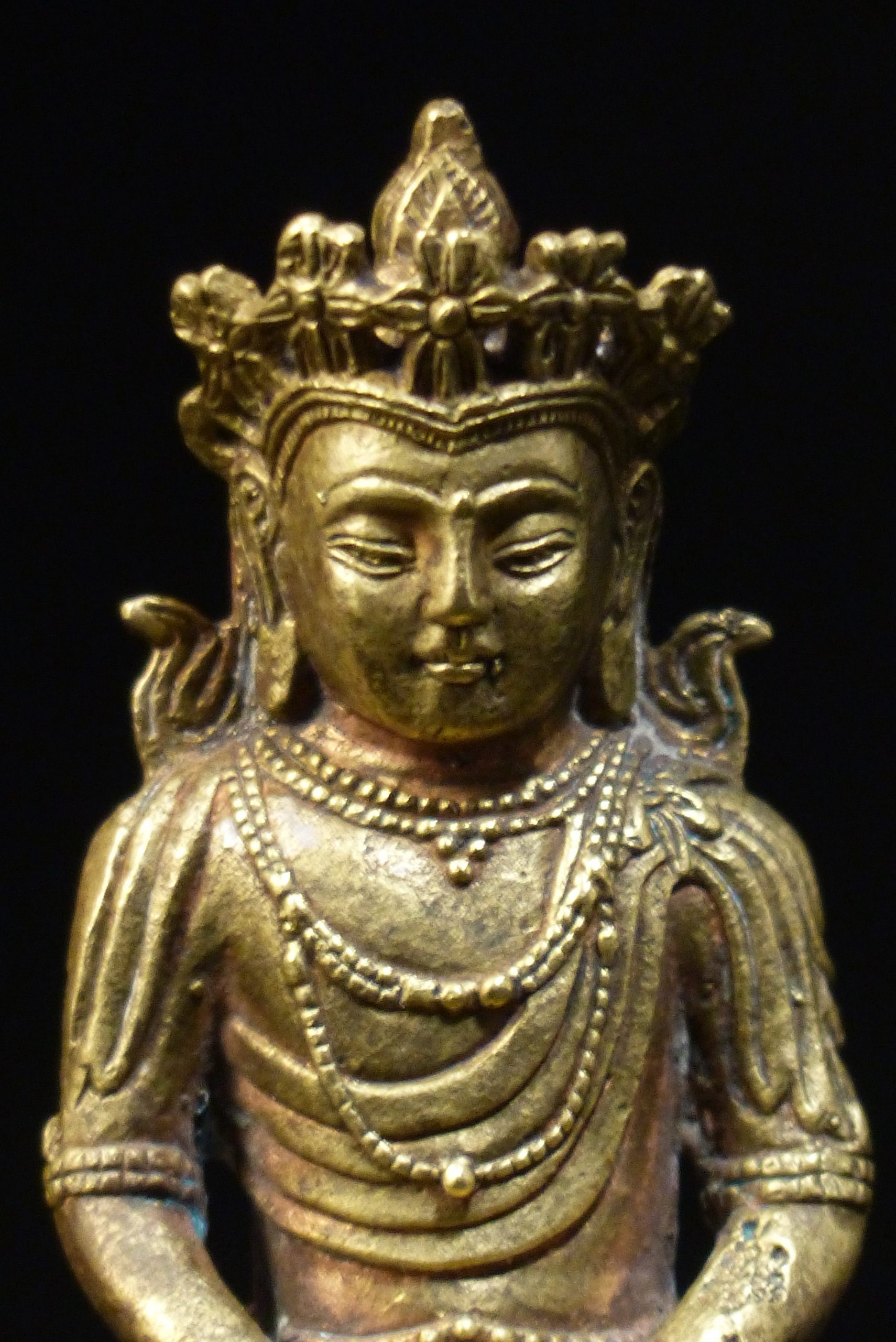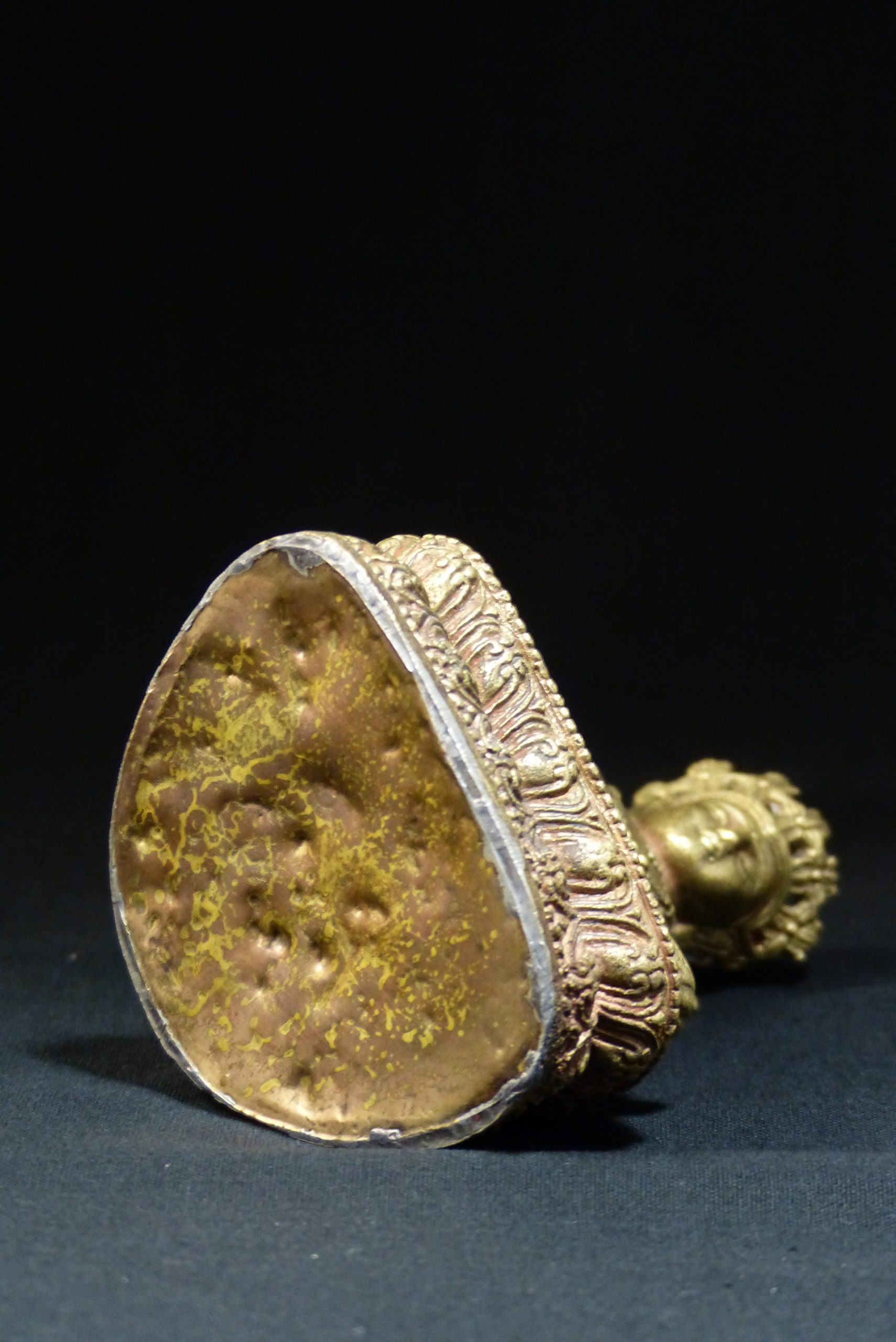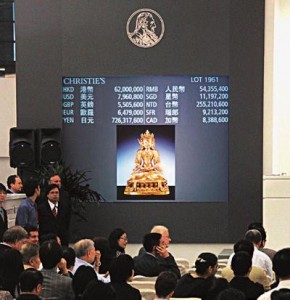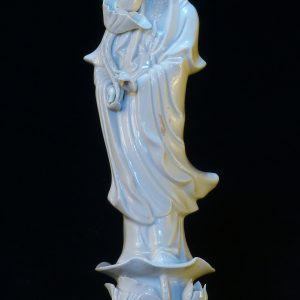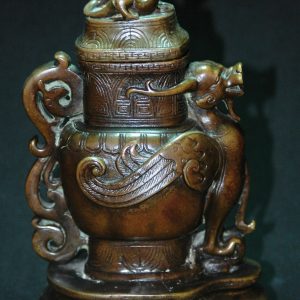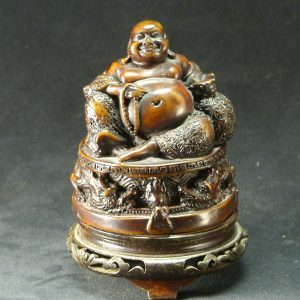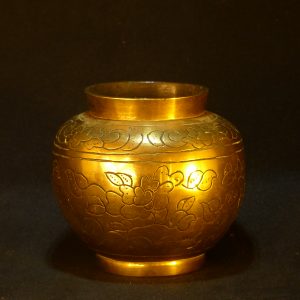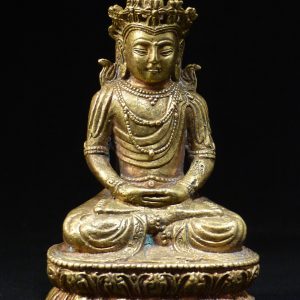Description
明 铜鎏金无量寿佛坐像
参考:佳士得
9 5月 2018 | 現場拍賣 16723
佩吉及大衛‧洛克菲勒夫婦珍藏:旅遊及美國文物
拍品 982 清康熙 15世纪 汉藏宫廷 铜鎏金嵌宝无量寿佛
AN IMPERIAL GILT-BRONZE FIGURE OF AMITAYUS
CHINA, KANGXI PERIOD (1662-1722)
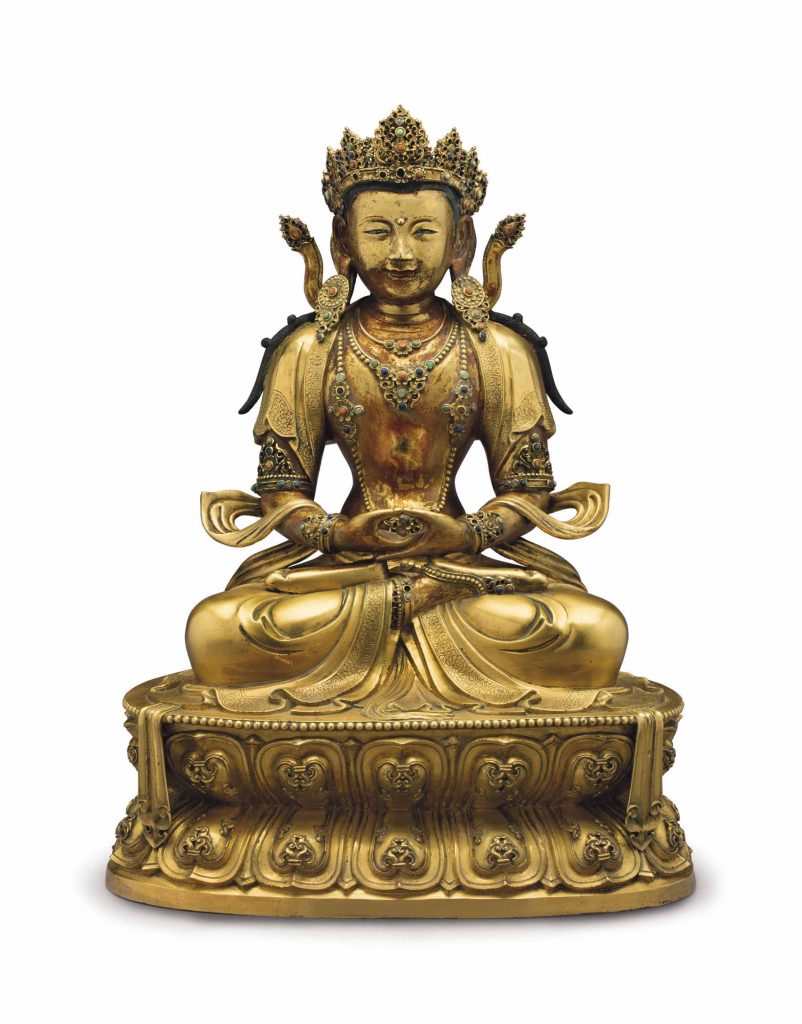
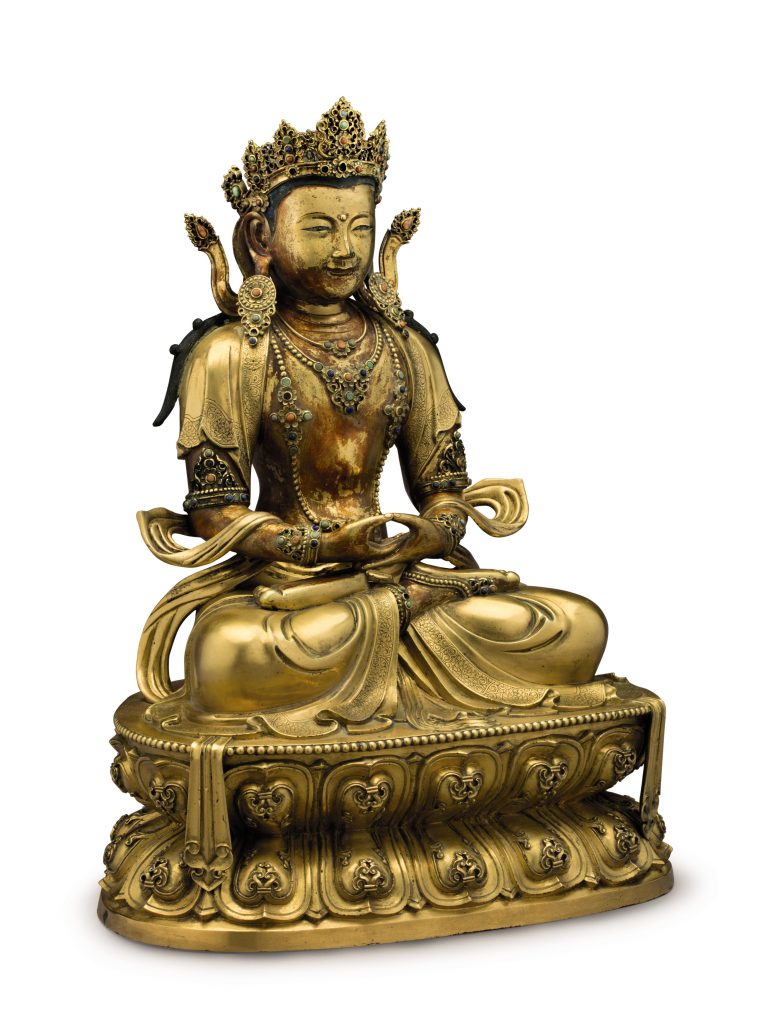
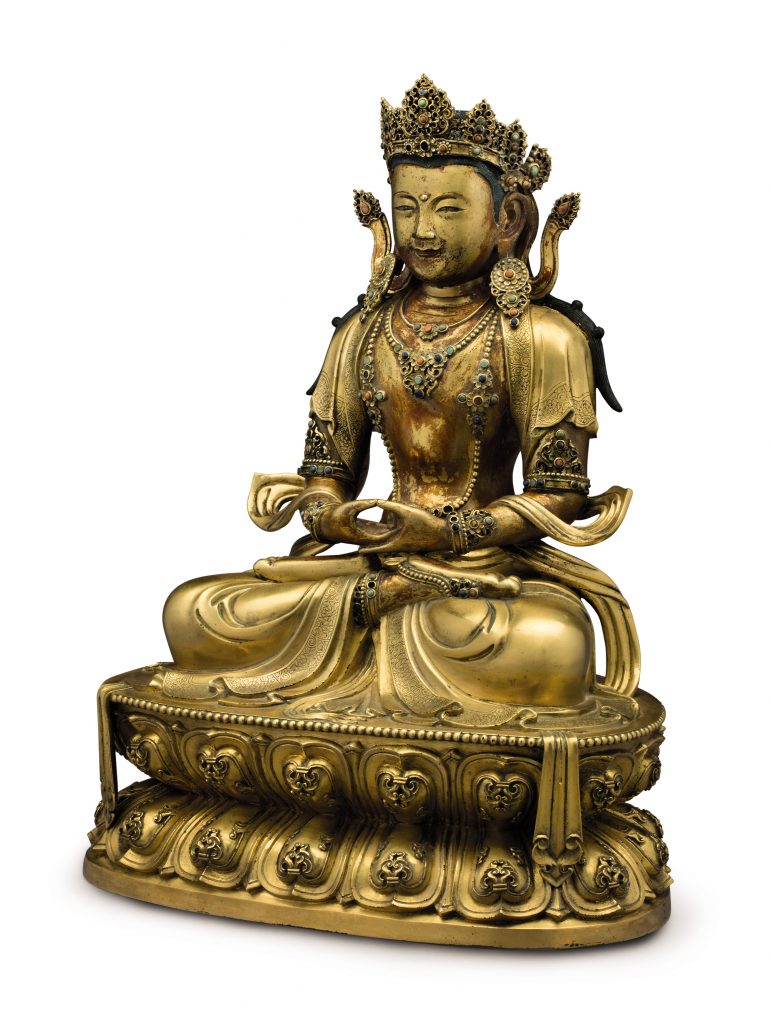
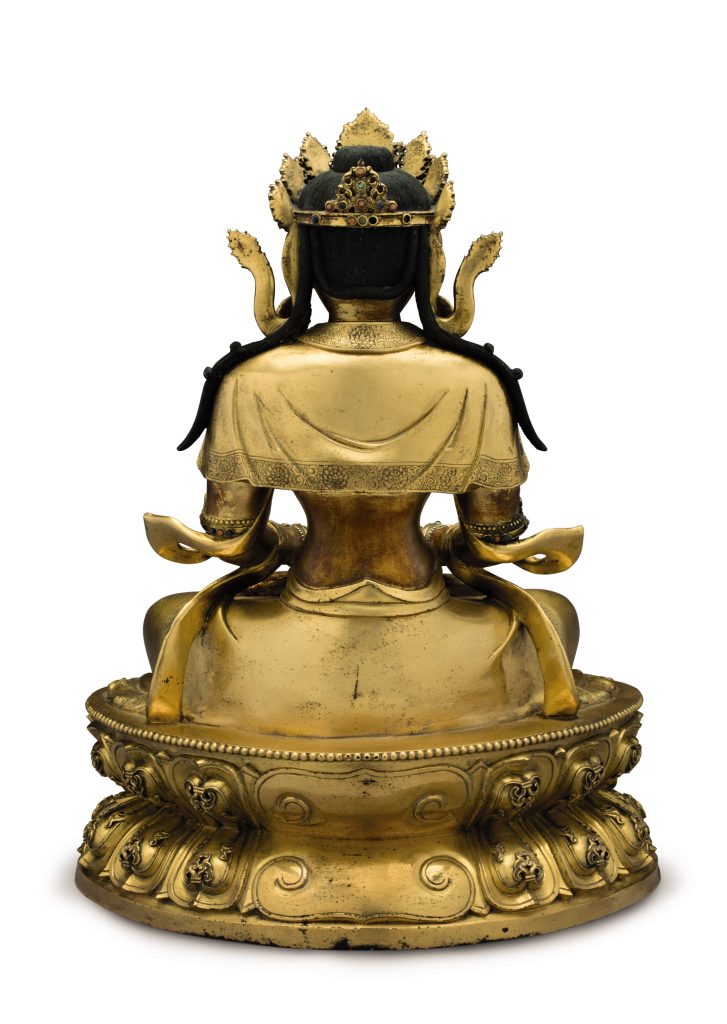
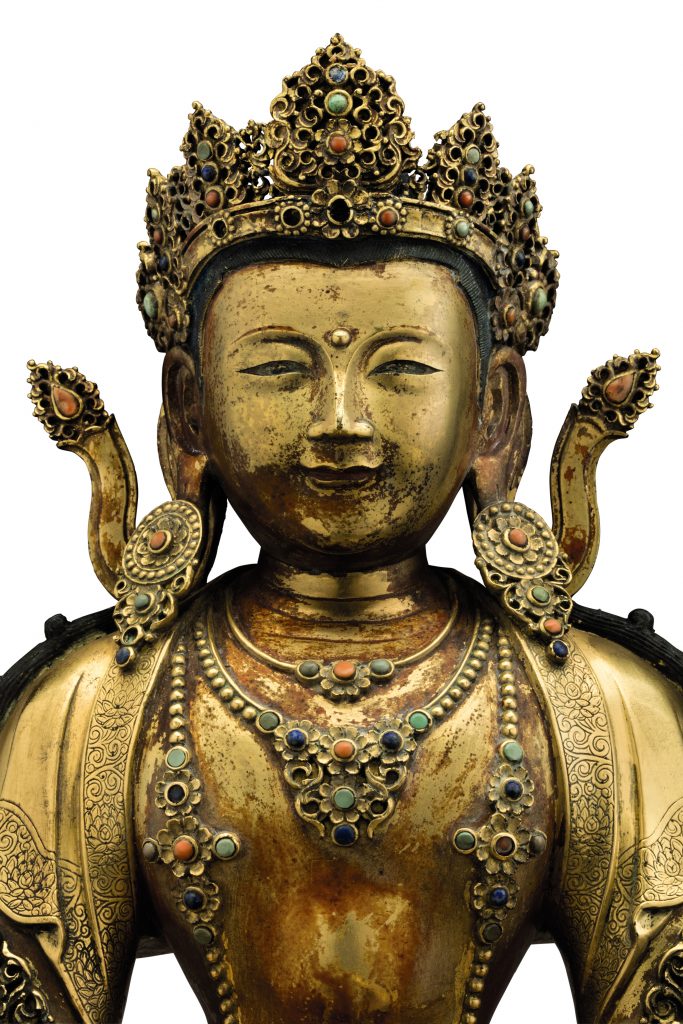
成交價 USD 2,532,500
估價 USD 400,000 – USD 600,000
AN IMPERIAL GILT-BRONZE FIGURE OF AMITAYUS
CHINA, KANGXI PERIOD (1662-1722)
細節
AN IMPERIAL GILT-BRONZE FIGURE OF AMITAYUS
CHINA, KANGXI PERIOD (1662-1722)
Seated in dhyanasana on a double-lotus base with the hands held in dhyanamudra, clad in a voluminous dhoti and adorned with various jewelry and with a rippling ribbon, the ends of which elegantly fall over the front edge of the base, the face with serene expression flanked by large foliate earrings and surmounted by an elaborate tiara secured at the back by flared ties
16 ½ in. (41.9 cm.) high
來源
Laurance S. Rockefeller, New York, by 1994.
Estate of Laurance S. Rockefeller, 2004.
Laura Rockefeller Chasin, 2004-2006.
Acquired in 2006.
出版
W. Adelson et al., The David and Peggy Rockefeller Collection: Supplement, New York, 2015, vol V, pp. 217-218, no 103 (incorrect image reproduced).
注意事項
On occasion, Christie’s has a direct financial interest in the outcome of the sale of certain lots consigned for sale. This will usually be where it has guaranteed to the Seller that whatever the outcome of the auction, the Seller will receive a minimum sale price for the work. This is known as a minimum price guarantee. This is a lot where Christie’s holds a direct financial guarantee interest.
狀況報告
We have sought to record changes in the condition of this piece acquired after its initial manufacture.
-figure would have held a vase in his hand, which is now missing
-wear to gilt lacquer on face and body
-some of the inlay missing
-repaired break to the center of the foliate tiara with associated small losses
-separately cast chignon is missing
-small areas of wear to the heavy gilding in particular along the lower back edge of the base
-the base is unsealed
拍品專文
As a newly established dynasty, the Qing, who were themselves Manchus and not of Han Chinese descent, relied on the discipline and support of other foreign ethnic groups, including the Mongolians and Tibetans, for their dominance of China proper. In the pursuit of this goal, the Manchus propagated and heavily patronized Tibetan-style Buddhism. As early as the Yuan dynasty, the Mongolians had relied on the spiritual wisdom of Tibetan Buddhist masters as guidance in matters both religious and secular. They would consult with Tibetan lamas (teachers), for instance, prior to battle, and believed that subsequent victories were the result of their karmic righteousness. In the following centuries, Mongolian adherence to Tibetan Buddhism only increased, and the Qing Emperors took advantage of this devotion by lavishly patronizing Buddhist activities in both the capital of Beijing and in areas closer to Mongolia. During the reigns of the Kangxi, Yongzheng, and Qianlong Emperors, several Tibetan Buddhist temples were constructed in Beijing and in Inner Mongolia and filled with lamas from Tibet, who increasingly took on administrative roles within the secular government.
Although the Kangxi Emperor may have propagated Tibetan Buddhism initially as a means to control the Mongol tribes, he eventually became a devout Buddhist himself. After 1696, he increasingly came under the sway of the Mongolian lama and artist, Zanabazar, and from 1701 until 1723 alone, he himself produced more than four hundred handwritten versions of the Heart Sutra and Medicine Buddha Sutra. He also commissioned large-scale gilt-bronze images of various Buddhist deities during his reign. A gilt-bronze figure of Shadakshari Avalokiteshvara, now in the collection of the Beijing National Palace Museum, was commissioned by the Kangxi Emperor in memory of his recently deceased grandmother, the Empress Dowager Xiaozhuang; the poetic inscription, incised along the base in Tibetan, Chinese, Manchurian, and Mongolian, dates the work to the 25th year of his reign, corresponding to 1686 (see The Complete Collection of Treasures of the Palace Museum – Buddhist Statues of Tibet, Hong Kong, 2008, p. 237, no. 226). Another large-scale (69.2 cm. high) gilt-bronze image of Dipankara Buddha, now in the collection of the Rhode Island School of Design, is dated by its inscription to 1662 and was likely presented to an important monastery in Tibet as a gift.
Many of the massive gilt-bronzes commissioned during the Kangxi Emperor’s reign, however, do not bear inscriptions, making their purpose more difficult to ascertain. As the Qing Emperors, and in particular Kangxi, constantly sought to associate themselves with the deity Manjushri, one can surmise that the large gilt-bronze figure of Four-Armed Manjushri in the collection of the Bishishangzhuang (Summer Palace) at Chengde, illustrated by Wang Jiapeng, et al., Buddhist Art from Rehol: Tibetan Buddhist images and ritual objects from the Qing dynasty Summer Palace at Chengde, Taipei, 1999, p. 81, no. 19, was a propagandistic attempt at divine association. The nature behind the present work is not entirely known, but it is often suggested that such cast images of Amitayus were commissioned for the birthdays of the Emperor or his royal family. As Amitayus was considered to be the deity of long life, images of the bodhisattva were fitting gifts for such occasions. In the reign of the Qianlong Emperor (1736-1795) for instance, thousands of small, and significantly less expensive, images of Amiyaus were cast for the sixtieth, seventieth, and eightieth birthdays of Qianlong’s mother, the Empress Dowager Xiaoshengxian.
A number of identical examples to the present work are known, both in museum and private collections, and have appeared on the market in recent years. All are almost identical in weight and proportions, indicating they were likely cast from a mold, and many retain some gilt lacquer and cold gold on the torso and face, as in the present example. It is unclear if they were cast at different times or as a single group, but many, including the current work, bear numbers inscribed under the edge of the base. Whether they were cast individually or at one time, an enormous amount of bronze and gilding would have been required for each image, and would thus have been an extremely important commission.
参考:佳士得
12月3日 | 現場拍賣 20163
重要中國瓷器及工藝精品
拍品 3043
A GILT-BRONZE SEATED FIGURE OF AVALOKITESVARA
明十五世紀 鎏金銅觀音坐像
MING DYNATY, 15TH CENTURY
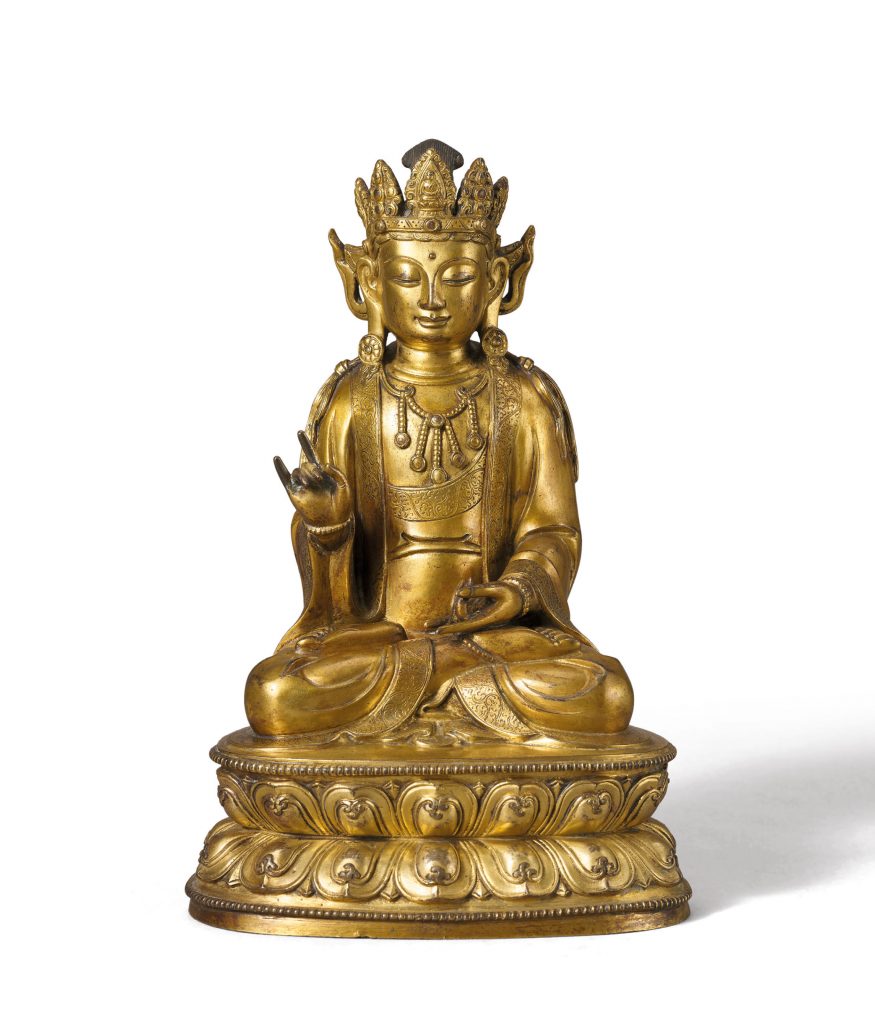
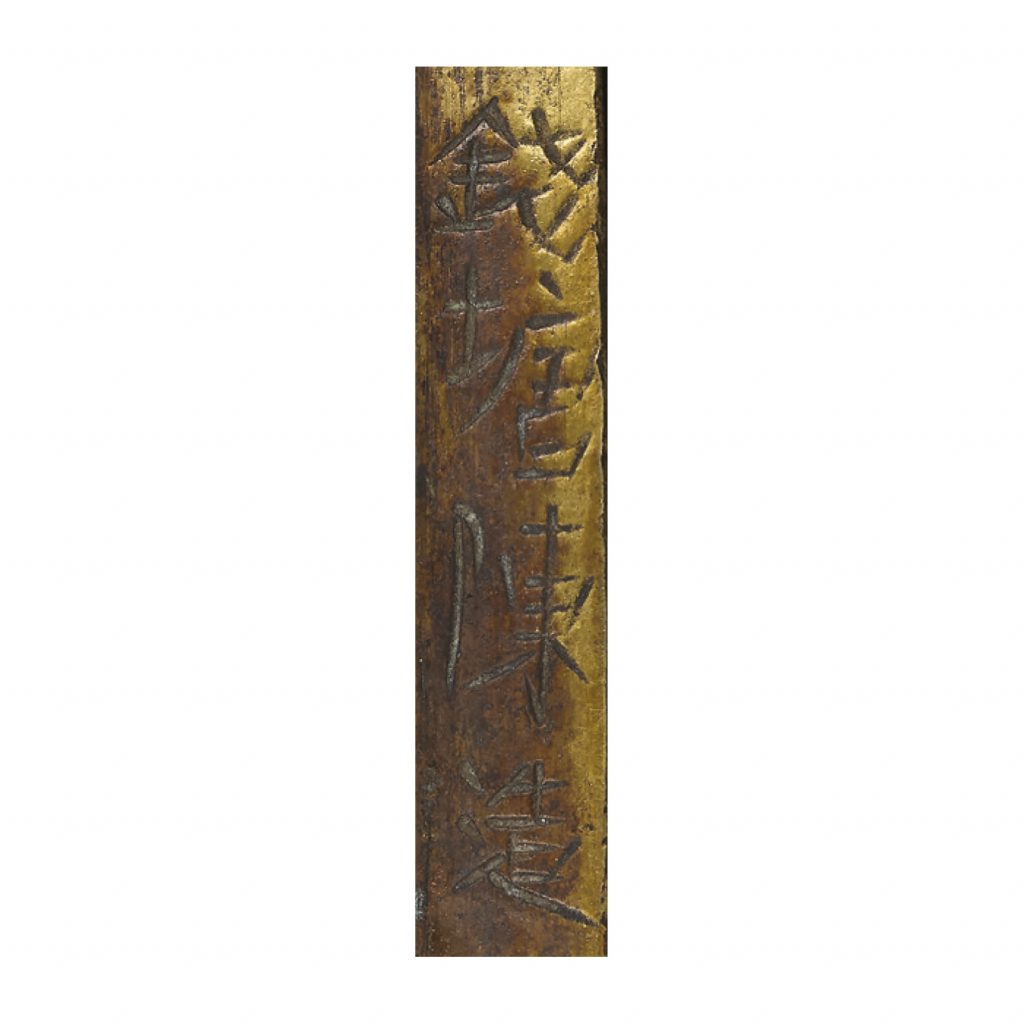
估價 HKD 500,000 – HKD 800,000
明十五世紀 鎏金銅觀音坐像
11 in. (28 cm.) high
拍品專文
款識:錢塘陳造
本像造型古樸大方,寶相莊嚴,據款識為明初陳彥清所造。比較另外兩尊帶陳彥清銘款及年款的鎏金銅造像,一為紐約大都會博物館藏老子像,據銘文斷代1438年,一為芝加哥美術館藏真武像,據銘文斷代1438年1439年。另參考一尊帶陳彥清款但無年款的鎏金銅釋迦牟尼像,2017年11月8日於倫敦蘇富比拍賣,拍品67號。
参考:佳士得
5月30日 2018 | 現場拍賣 16265
香港
正觀自在 — 佛教藝術精品
VARIOUS PROPERTIES
LOT 2861明永樂 鎏金銅無量壽佛坐像 「大明永樂年施」刻款
A RARE GILT-BRONZE FIGURE OF AMITAYUS
YONGLE INCISED SIX-CHARACTER PRESENTATION MARK AND OF THE PERIOD (1403-1424)


Price realised HKD 3,460,000
Estimate HKD 2,800,000 – HKD 4,000,000
A RARE GILT-BRONZE FIGURE OF AMITAYUS
YONGLE INCISED SIX-CHARACTER PRESENTATION MARK AND OF THE PERIOD (1403-1424)
The deity is seated majestically with legs crossed in dhyanasana, the hands in dhyana mudra, held above the thighs and holding a kalasa. The rounded face is finely modelled with an urna between the arched eyebrows with eyes downcast providing a benevolent expression, the hair swept back in a topknot behind an elaborate crown with short sashes tied behind the ears, wearing a shawl over the broad shoulders revealing a bare torso festooned with complex beaded jewellery chains, the long dhoti secured by a belt decorated with rosettes around
the narrow waist. The front of the beaded double-lotus base is incised with a six-character presentation mark, Daming Yongle Nianshi, ‘Bestowed in the Yongle period of the Great Ming Dynasty’.
7 in. (18 cm) high
Provenance
Acquired in San Francisco in the 1990s
Lot Essay
The present figure belongs to a very rare group of smaller sized Buddhist images from the Yongle period that are finely and skilfully cast. Other similar Yongle-marked gilt-bronze figures from this group include a slightly larger (20.5 cm. high) seated figure of Amitayus with a cold-painted face in the State Hermitage Museum, St Petersburg, inventory number y-656; a standing figure of Amitayus of comparable overall height (18.4 cm. high), sold at Christie’s Hong Kong, 3 June 2015, lot 3009 (fig. 1); and a standing figure of Sakyamuni (19 cm. high) from the Speelman Collection, sold at Sotheby’s Hong Kong, 7 October 2006, lot 803. Buddhist images from the first half of the fifteenth century were greatly influenced by the art of Tibet. In the preceding century under the Yuan Dynasty, the authority of Mongol rulers had become closely associated with Tibetan Buddhist or Lamaist rituals. The tradition of Lamaist art continued into the Ming period and prevailed in works of art such as the present sculpture.
Pre-Lot Text
VARIOUS PROPERTIES
細節
明永樂 鎏金銅無量壽佛坐像 「大明永樂年施」刻款
7 in. (18 cm) high
來源
1990 年代於美國三藩市入藏
狀況報告
謹請注意,所有拍品均按「現狀」拍賣,閣下或閣下的專業顧問應於拍賣前親自查看拍品以評鑑拍品之狀況。
– 鎏金表面略有磨損、微磕和撞痕,包括背部有一針頭大小的凹痕,屬正常現象。
– 裝藏板經分開保存。
拍品專文
無量壽佛面相方正,神態仁慈。頭戴花冠,高結髮髻。袒上身,肩披帔帛,配飾纓絡。手持寶瓶,結跏跌坐於蓮花寶座,上刻「大明永樂年施」楷書款。本尊無量壽佛是永樂時期為數不多的製造精良且尺寸較小的佛造像之一。其他同時期類似的銅鎏金佛造像可比較一尊較大無量壽佛坐像(20.5 公分高),藏於聖彼得堡冬宮,編號y-656;一尊無量壽佛立像(18.4 公分)於2015 年6 月3 日經香港佳士得拍賣,拍品3009 號(圖一);以及Speelman 舊藏一尊釋迦牟尼立像,於香港蘇富比2006 年10 月7 日拍賣,拍品803 號。十五世紀上半葉的佛造像受西藏影響深遠。元代時,蒙人掌權者與藏傳佛教及喇嘛教儀式聯繫緊密,此傳統延續到明代,在本尊佛像上有所體現。
参考:佳士得
5月30日 2018 | 現場拍賣 16265
正觀自在 — 佛教藝術精品
香港
29 5月 2018
LOT 2867 清康熙 鎏金銅無量壽佛坐像
A GILT-BRONZE FIGURE OF AMITAYUS
KANGXI PERIOD (1662-1722)



成交價 HKD 4,900,000
估價 HKD 1,500,000 – HKD 1,800,000
Price realised HKD 4,900,000
Estimate HKD 1,500,000 – HKD 1,800,000
A GILT-BRONZE FIGURE OF AMITAYUS
KANGXI PERIOD (1662-1722)
The figure is shown seated in dhyanasana on a separately cast double petalled lotus base, with his hands in dhyanamudra. He wears a voluminous dhoti delicately incised with floral patterns and adorned with various jewellery, the face with serene expression flanked by large foliate earrings and surmounted by a five-peaked ornate tiara.
9 ½ in. (24 cm.) high
Lot Essay
The current figure belongs to a group of finely cast imperial gilt bronze figures from the Kangxi period. Compare to a similar gilt bronze figure of Avalokitesvara from this group, sold at Christie’s Hong Kong, 28 Novebmer 2012, lot 2265 (fig. 1).
清康熙 鎏金銅無量壽佛坐像
KANGXI PERIOD (1662-1722)
成交價 HKD 4,900,000
估價 HKD 1,500,000 – HKD 1,800,000
清康熙 鎏金銅無量壽佛坐像
KANGXI PERIOD (1662-1722)
細節
清康熙 鎏金銅無量壽佛坐像
9 ½ in. (24 cm.) high
狀況報告
謹請注意,所有拍品均按「現狀」拍賣,閣下或閣下的專業顧問應於拍賣前親自查看拍品以評鑑拍品之狀況。
造像:
– 總體品相良好。
– 缽已失。
– 部分鑲嵌已失,部分被更換。
– 裝藏板曾被打開。
– 有少量凹痕、微磕和磨損,屬正常現象。
底座:
– 一向上蓮瓣已失,部分蓮瓣刻有數字。
– 有少量凹痕、微磕和磨損,屬正常現象。
拍品專文
北京宮廷,漢藏風格。無量壽佛又稱長壽佛,為清代宮廷造像中代表性題材。清代皇帝為祈福長壽,頌揚帝王如佛陀在世護持人間,並命宮廷造辦處鑄造了大量風格各異的無量壽佛。這尊無量壽佛坐像是典型的清康熙宮廷金銅造像作品。康熙造像以選材考究,銅質精密,鑄造精湛,雕刻嫺熟、裝飾繁縟、鎏金亮麗而著稱,總體上給人一種雍容華貴的皇家氣韻。現存典型的清康熙造像市場中並不多見,一直是藏家所追逐的物件。此尊造像面型端莊俊秀、造型比例精准、裝飾繁縟華麗,鎏金亮麗悅目,蓮座工整大氣都具有清康熙金銅造像的藝術特點。寶冠、耳璫、繒帶、瓔珞、釧環及衣飾均雕刻細膩精緻,一絲不苟,顯示出高超的藝術水準。整像通體鎏金,胎體厚重,做工考究,為現存清康熙造像的精品。該造像最為殊勝之處在於分體鑄造,而且主尊和蓮花台座皆保存原裝鎏金封底。從蓮瓣形式看,顯然受到了喀爾喀蒙古造像的影響。可參閱香港佳士得2012 年11 月28 日拍品2265 號(圖一),與此尊造像藝術風格和製作工藝完全如出一轍,出自宮廷造辦處,應屬於清康熙宮廷造像一組作品。也可參閱一尊清康熙五十二年乾漆夾紵無量壽佛,載於黃春和著《藏傳佛像藝術鑒賞》,2004 年,彩圖72,其為典型的康熙宮廷造像,與此尊造像具有相同的藝術風格。
参考:十七世纪 内地 藏传佛教铜鎏金无量寿佛造像



金铜佛造像走俏拍坛
金铜佛造像,一般是指铜质鎏金的佛教造像,但实际上未鎏金的铜佛像,也往往被收藏爱好者归入金铜造像的范围中。…
Continue Reading »

![[临渊阁]天地一家春](https://www.antiquekeeper.ca/wp-content/uploads/2023/03/cropped-Asian-Art-Wallpaper-Painting3-6-2.jpg)

